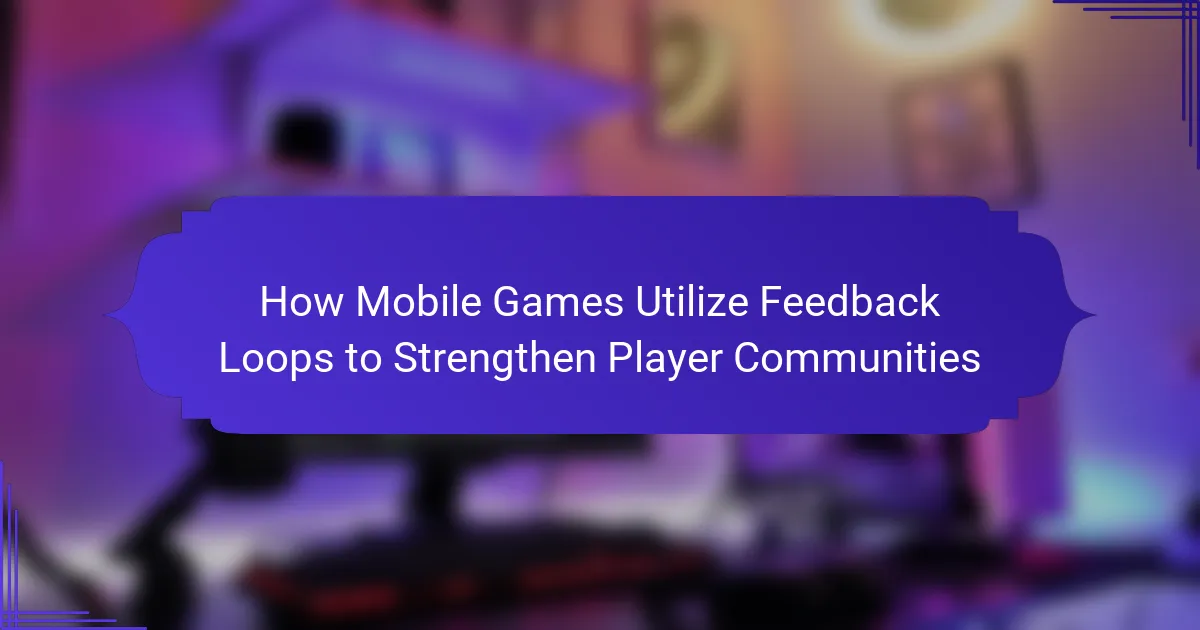Mobile games thrive on player engagement, and feedback loops are key to fostering strong communities. These loops enhance interaction through rewards, social connections, and collaborative goals. Players provide input that shapes game development, creating a sense of ownership and loyalty. Successful games like “Candy Crush Saga,” “Clash of Clans,” and “Fortnite” exemplify these strategies, driving retention and satisfaction.

How do feedback loops function in mobile games?
Mobile games utilize feedback loops to enhance player engagement and foster community. These loops create a cycle of reward and motivation, encouraging players to participate more actively.
Feedback loops in mobile games often include mechanisms such as rewards for achievements, leveling systems, and social interactions. For example, completing tasks can yield in-game currency or items, which players use to progress further. This progression incentivizes continued play and interaction with other players.
Social feedback loops also play a crucial role. Players can share achievements, compete on leaderboards, or collaborate in teams. This interaction strengthens community bonds and keeps players connected to the game.
Overall, effective feedback loops in mobile games drive player retention and satisfaction by creating a dynamic and engaging gaming experience.
What are the key components of a feedback loop?
Key components of a feedback loop in mobile games include player input, game response, and community engagement. Player input consists of actions and feedback provided through gameplay. Game response refers to the adjustments made by developers based on player behavior and feedback. Community engagement fosters interaction among players, enhancing their experience and encouraging collaboration. Together, these components create a dynamic system that strengthens player communities and improves game design.
How do feedback loops enhance player engagement?
Feedback loops significantly enhance player engagement by creating a dynamic interaction between players and game mechanics. These loops provide instant rewards, fostering a sense of achievement. As players receive feedback, they adjust their strategies, leading to increased investment in the game. This continuous cycle encourages community interaction, as players share tips and experiences, strengthening social bonds. Ultimately, feedback loops create a more immersive and satisfying gaming experience, driving player retention and community growth.
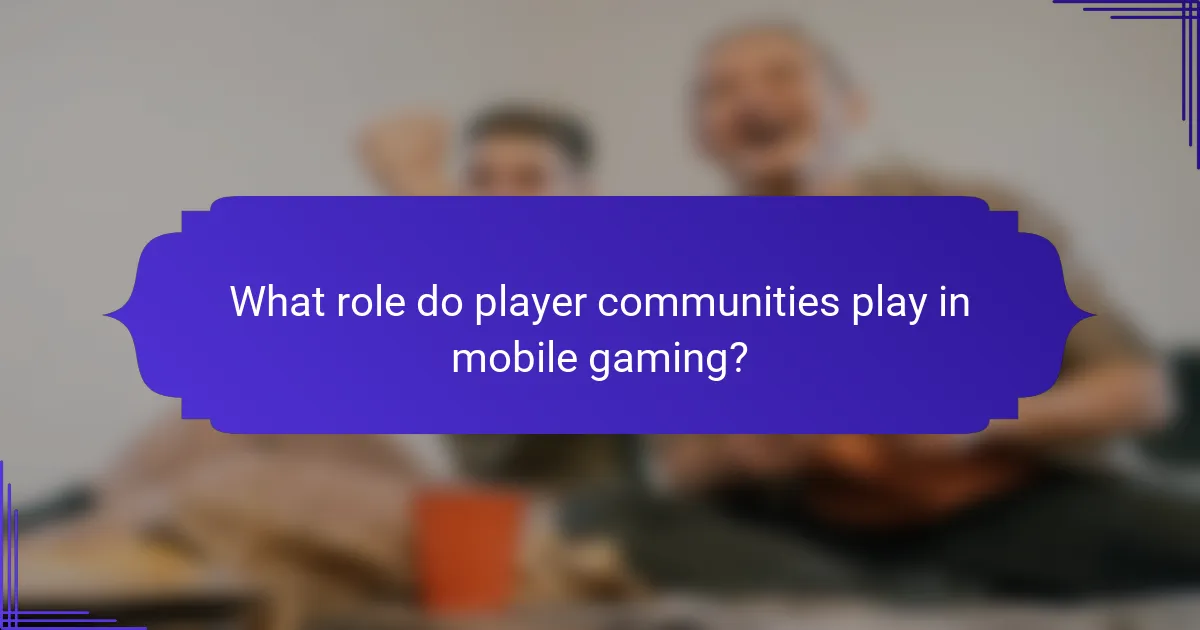
What role do player communities play in mobile gaming?
Player communities play a crucial role in mobile gaming by enhancing player engagement and retention. Feedback loops create dynamic interactions where players share insights, report issues, and suggest improvements. This exchange fosters a sense of belonging and loyalty, which is vital for game longevity.
Communities often influence game development through collective feedback, shaping updates and new features. Developers leverage this input to refine gameplay mechanics, ensuring they meet player expectations. As a result, games evolve in ways that resonate with their audience, deepening player investment.
Moreover, social connections within these communities drive participation in events and competitions, further strengthening player ties. This creates a vibrant ecosystem where players feel valued and heard, leading to sustained interest in the game.
Ultimately, the synergy between player feedback and community engagement is essential for the success of mobile games, making it a unique attribute of modern gaming culture.
How do communities influence game development?
Communities significantly influence game development by providing valuable feedback that shapes gameplay and features. Mobile games leverage feedback loops to strengthen player communities, fostering engagement and loyalty.
Developers often implement in-game surveys and community forums to gather player insights. This direct feedback allows for real-time adjustments to game mechanics, ensuring they meet player expectations. As a result, players feel their opinions matter, enhancing their connection to the game.
Moreover, developers use data analytics to track player behavior, identifying trends and preferences. This data helps refine game design and introduces new content that resonates with the community. Engaged players contribute to a vibrant ecosystem, sharing experiences and tips, further attracting new players.
In summary, mobile games that effectively utilize feedback loops create stronger player communities, leading to sustained interest and increased player retention.
What are the benefits of strong player communities?
Strong player communities enhance engagement, foster loyalty, and improve game development. They create a support system where players share experiences, tips, and feedback. This interaction leads to a more immersive gaming experience, as developers utilize player insights to refine gameplay. Additionally, vibrant communities can attract new players, increasing the game’s longevity and success.
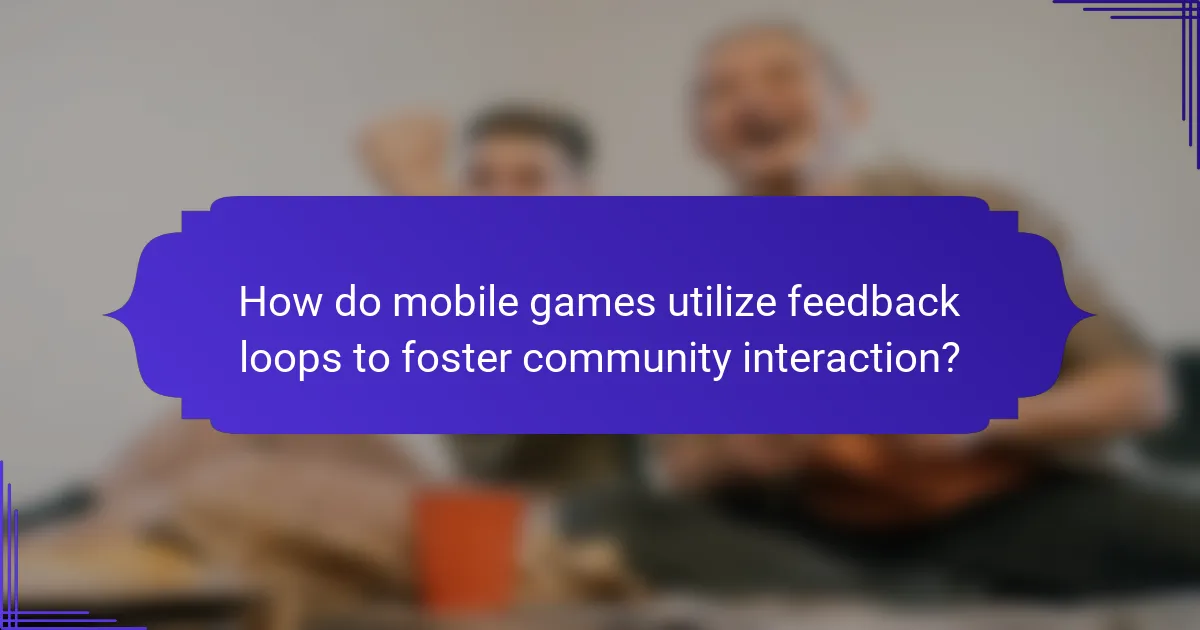
How do mobile games utilize feedback loops to foster community interaction?
Mobile games utilize feedback loops to strengthen player communities by fostering engagement and interaction. These loops encourage players to provide input, which developers use to enhance gameplay experiences.
Regular updates based on player feedback create a sense of ownership among users, leading to increased loyalty. Players feel valued when their suggestions influence game development, fostering a collaborative community atmosphere.
Incorporating social features, such as leaderboards and forums, amplifies interaction. Players can share achievements and strategies, further enhancing community bonds. This engagement is crucial for retention, as players are more likely to continue playing when they feel connected to others.
Additionally, reward systems tied to community milestones incentivize collaboration. As players work together to achieve specific goals, they build stronger relationships, enriching the overall gaming experience.
What types of feedback mechanisms are commonly used?
Mobile games commonly utilize feedback mechanisms such as in-game surveys, player analytics, social media interactions, and community forums. These tools enhance player engagement by allowing developers to adapt game features based on player preferences and behaviors. In-game surveys collect direct player opinions, while analytics track gameplay patterns. Social media interactions foster community discussions, and forums serve as platforms for player feedback. Each mechanism strengthens player communities by promoting communication and responsiveness to player needs.
How do social features integrate with feedback loops?
Social features enhance feedback loops by fostering communication and engagement among players. These interactions create a sense of community, encouraging players to share experiences and strategies. As a result, developers can gather real-time insights, allowing for timely adjustments to gameplay and features. This continuous feedback cycle strengthens player loyalty and satisfaction, ultimately benefiting the game’s longevity.
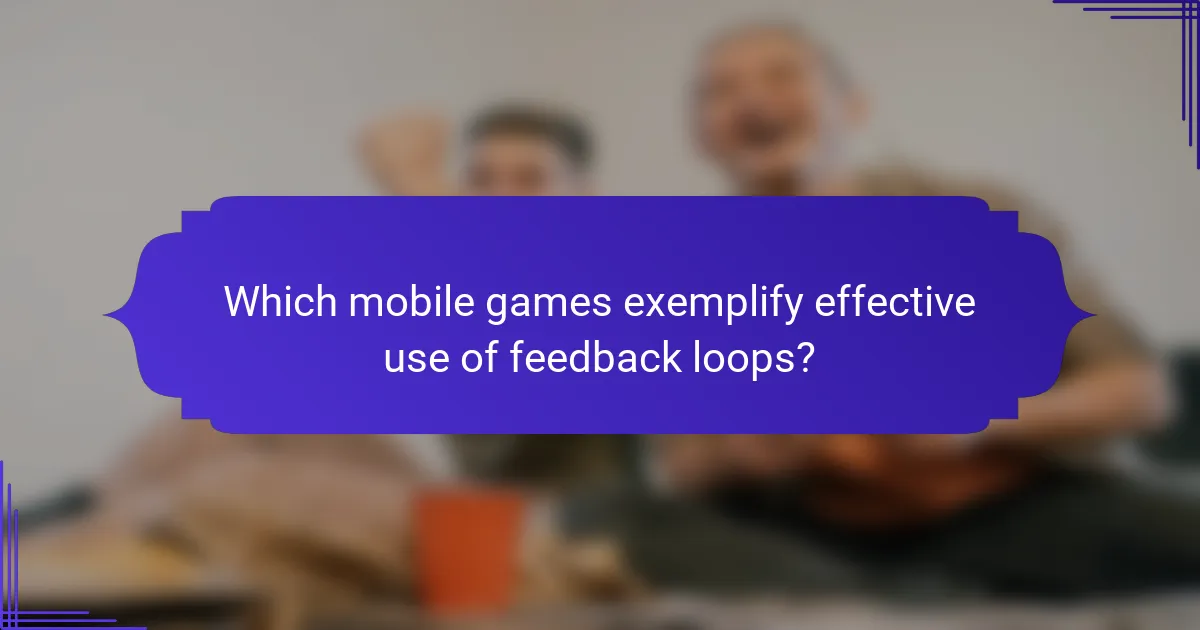
Which mobile games exemplify effective use of feedback loops?
Mobile games that effectively utilize feedback loops include “Candy Crush Saga,” “Clash of Clans,” and “Fortnite.” These games engage players through rewards, challenges, and community interactions.
“Candy Crush Saga” employs immediate feedback through level completion and rewards, enhancing player retention. “Clash of Clans” fosters community by allowing players to join clans, creating social feedback loops through collaboration. “Fortnite” uses seasonal events and challenges to keep the gameplay dynamic, providing ongoing feedback that encourages player investment.
These feedback mechanisms strengthen player communities by promoting interaction, competition, and shared goals.
What unique strategies do these games employ?
Mobile games employ unique strategies like dynamic reward systems and community-driven events to enhance player engagement. These feedback loops create a sense of belonging and encourage continuous interaction. For instance, games often implement tiered rewards based on player achievements, fostering competition and collaboration. Additionally, user-generated content and feedback influence game updates, ensuring that player preferences shape the gaming experience. This approach not only strengthens player communities but also enhances retention rates.
How do cultural differences affect feedback loop effectiveness?
Cultural differences can significantly impact feedback loop effectiveness in mobile games. Different cultures may interpret feedback uniquely, affecting player engagement and community dynamics.
For example, direct criticism may be well-received in some cultures but perceived as offensive in others. Understanding these cultural nuances helps game developers tailor feedback mechanisms, ensuring they resonate with diverse player bases.
Additionally, community norms can influence how feedback is given and received. In collectivist cultures, players may prioritize group harmony, leading to more supportive feedback. In contrast, individualistic cultures might encourage more direct and critical feedback.
Ultimately, recognizing and adapting to cultural differences enhances feedback loop effectiveness, fostering stronger player communities and improving overall game experience.
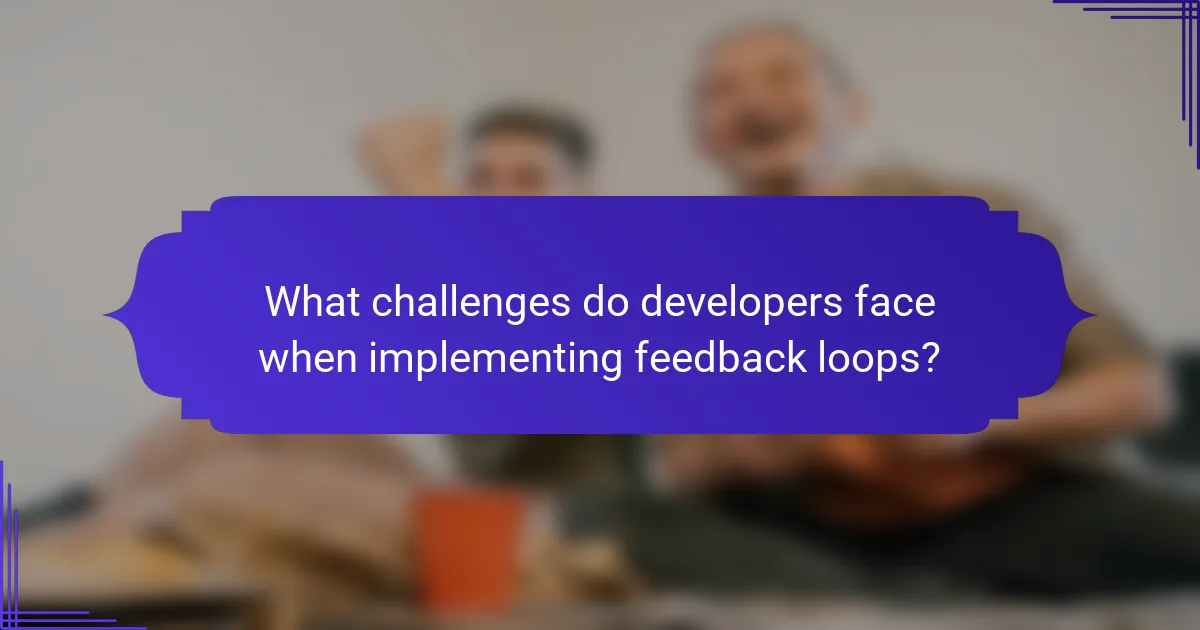
What challenges do developers face when implementing feedback loops?
Developers face challenges such as balancing player feedback with game design goals, managing diverse player expectations, and integrating feedback into existing systems. These factors can complicate the implementation of effective feedback loops. Additionally, maintaining a consistent user experience while adapting to feedback can strain resources and lead to potential conflicts in gameplay balance.
How can negative feedback be managed within communities?
Negative feedback can be managed effectively within communities by fostering open communication and encouraging constructive criticism. Mobile games utilize feedback loops to enhance player engagement and community cohesion. Developers can create forums or in-game systems where players feel safe sharing their concerns. This approach allows players to voice their opinions while developers can respond promptly, showing that feedback is valued. Regular updates based on player suggestions can also strengthen community trust and loyalty. By implementing these strategies, negative feedback transforms into a tool for growth and improvement.
What are common pitfalls in designing feedback systems?
Common pitfalls in designing feedback systems include lack of clarity, insufficient integration, and neglecting player engagement. Clear communication of feedback is crucial; ambiguous messages can confuse players. Integration of feedback into game mechanics is often overlooked, leading to disconnection between player input and game response. Additionally, failing to actively engage players in the feedback process can diminish community trust and participation.
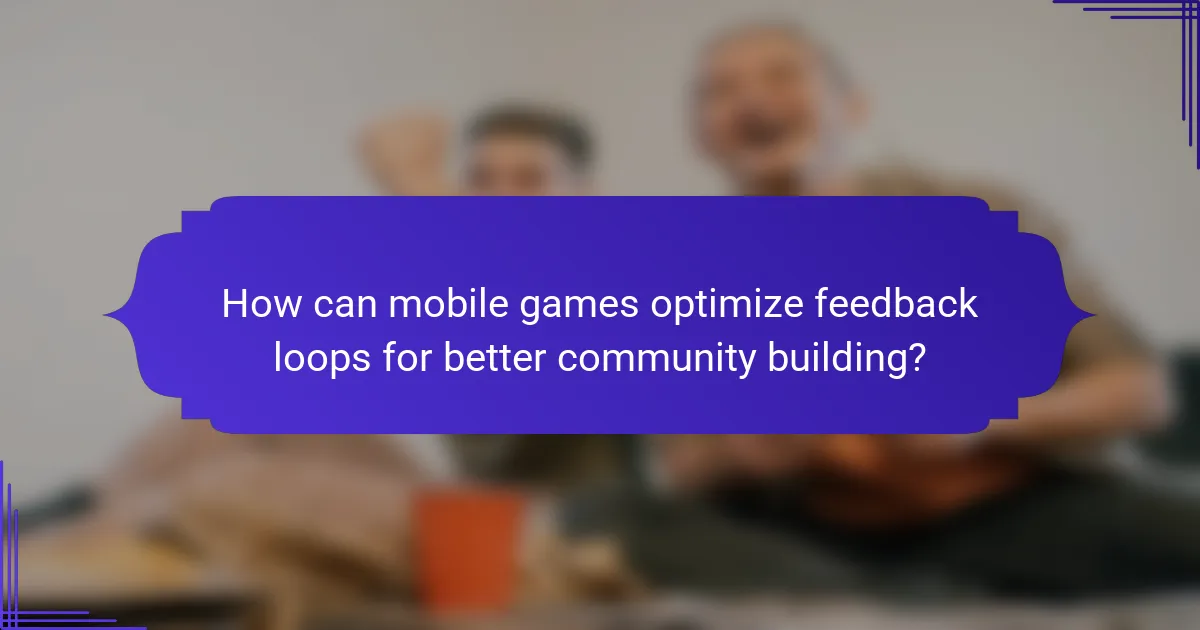
How can mobile games optimize feedback loops for better community building?
Mobile games optimize feedback loops to enhance community building by fostering engagement and communication. These games utilize player feedback to shape updates, events, and features, ensuring that community needs are met. Real-time feedback mechanisms, such as in-game surveys and forums, allow developers to understand player preferences. As a result, players feel valued and more connected to the game and each other.
Additionally, mobile games often implement reward systems that encourage player participation in feedback activities. These systems can include in-game currency, exclusive items, or recognition within the community. Such incentives not only motivate players to provide feedback but also strengthen their sense of belonging.
Moreover, the integration of social features, like team challenges and leaderboards, creates opportunities for players to collaborate and compete. This interaction fosters a vibrant community atmosphere, where players share experiences and strategies. Ultimately, these feedback loops create a dynamic environment that adapts to player input, enhancing overall satisfaction and loyalty.
What best practices should developers follow?
Developers should prioritize player engagement, implement regular feedback loops, and foster community interaction. These practices enhance player satisfaction and strengthen the overall gaming community.
First, actively gather player feedback through surveys and in-game prompts. This data helps developers understand player preferences and pain points.
Second, use feedback to make iterative updates. Regularly releasing patches based on player input keeps the game fresh and responsive to community needs.
Third, create platforms for community interaction, such as forums or social media groups. These spaces allow players to connect, share experiences, and provide ongoing feedback.
Lastly, recognize and reward player contributions to the community. Acknowledging feedback fosters loyalty and encourages continued engagement.
How can data analytics improve feedback loop strategies?
Data analytics enhances feedback loop strategies in mobile games by enabling data-driven decision-making. It allows developers to track player behavior, preferences, and engagement levels, leading to tailored experiences that strengthen community bonds. By analyzing feedback, developers can identify trends and adjust game features accordingly, fostering a responsive environment. This iterative process not only improves player satisfaction but also encourages ongoing participation, creating a vibrant player community.
What common mistakes should developers avoid when utilizing feedback loops?
Developers should avoid neglecting player feedback, implementing changes without testing, ignoring analytics, and failing to communicate updates. These mistakes can weaken player engagement and community trust. Prioritize understanding player needs and iterating based on their input to enhance the gaming experience.
